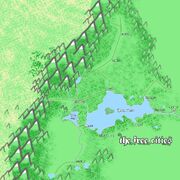Regions, locations, and history of different parts of Anuron.
The Free Cities[]

Free Cities Region
The Free Cities are a collection of independent cities and towns that are named for their political structure. Approximately 200 years prior to present day, a large group of humans journeyed from the eastern coast of Anuron to relocate to the frontiers forests, marshes, hills, and mountains that surround the massive great lake Rinar. Home to a fallen elven kingdom, the new occupiers built their homes amidst and ontop the ruins of a great elven civilization, lost many centuries ago during The Age of Dragons. Capital cities are cultural and population centers that dictate policy and protection to the surrounding establishments, with borders, annex rights, and taxation rights negotiated by city councils betwixt the larger cities and the democratically elected mayors. In times of great trouble, all the cities band together to stop invaders or troublesome forces. However, The Free Cities have enjoyed a moderate amount of peace given their seclusion to the rest of the world, with most trouble being in-fighting and disputes between the different leaders and the trouble that comes from the slow-to-adapt mixed democratic process. The people are mostly satisfied with their rulers, as the setting offers a great deal of freedom and indepenence, both on an individual level and among denizens of a city.
To the south and west lies the Thainland, the kingdom of Halflings. The Free Cities sometimes meet the halflings that journey north, most often selling fruits, foodstuffs, and other minor trinkets. Sometimes the halflings make it as far north as Rivermeet, but most often stop in the city of Anginar, which has a friendly attitude toward its halfling neighbors, and even has a small, permanent halfling population.
Directly west hosts a tattered, broken landscape known as the Deadlands. The stories that marry conversations about the Deadlands are full of fancy, containing all manner of wild tales regarding the harsh landscape and the beasts that are rumored to call it home. Few dare venture into the Deadlands, and those that do most often never return. A great wall dubbed the West Weald functions to keep out anything that might invade The Free Cities in force, and to warn any travelers of the dangers.
To the north rests the Dwarven kingdom of Valinaer. Dwarven rule once stretched to the southern coast via the Great Spine mountain range, and across the World's Crown, but their once mighty empire has receded just to the northern head of The Spine. The Dwarves were not hit as hard as the Elves during The Age of Dragons, but trouble with barbarians, poor leadership, the newcomer humans, and a lack of reason to maintain military establishments against the defeated elves forced the Dwarves to fall back to their capital city of Spherule and her surrounding lands. Towards the end of the dragon war a millenia ago, Dwarf Houses and Clans dissolved away, were absorbed into larger houses, or stubbornly fought the changing rule and were swept aside by the more powerful. The great highway that runs through The Spine is still intact, however, even though some smaller causeways and secret tunnels have gone to dissuse, collapsed, or were closed off by the Elves. Dwarven merchants, stonemasons, ore barons, and sellswords still make the journey down the great highway to lend their services to the human dominated Free Cities. Farstep hosts the greatest Dwarven population in the Free Cities, followed by Midbol, Palik, and Rivermeet respectively.
To the east and south flow the rivers, marshes, and great jungles of the Storm Lands. Fueled by the mighty Rinar River that splits the continent geographically in half, the south teams with tributaries, lakes, and great swamps that give host to deadly beasts. Orcs thrive in the chaotic environment, raiding caravans and killing travelers that would dare the troubled waters. The raiders are rarely organized enough to threaten The Free Cities, but do occasionally attack small towns or isolated trading posts.
Noteable Locations[]
- Rivermeet: at the intersection of the Wyst and Broc rivers sits Rivermeet. Enjoying the healthy trade established by the river crossing, as well as the relative proximity to natural resources in the north and robust farmland to the south, Rivermeet's population exceeds 30,000 individuals in the summer, if you count the outlying town, and drops as low as 25,000 during the height of winter. It hosts a council of nine members that dictate the surrounding lands laws, taxation, and protection.
| Demographics | Religion | Holidays | Landmarks |
|---|---|---|---|
| 78% Human | 55% Pelor | Summer Solstice (Pelorian) | Stone Keep |
| 9% Elf | 25% St. Cuthbert | Winter Solstice (Cuthbertine) | 12' Stone walls |
| 6% Dwarven | 8% Lorethian | Autumnberfest | Outer-town |
| 5% Half-Elf | 2% Boccob | Springfest | Arena |
| 2% Other | 10% Other or none | Bi-yearly Ranger Games | Bridges |